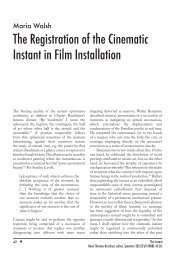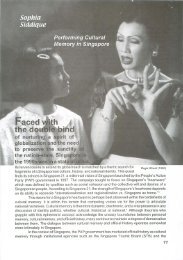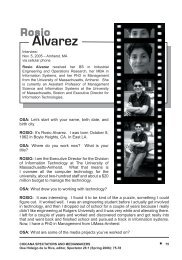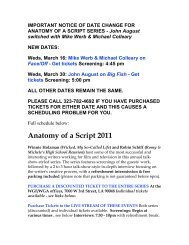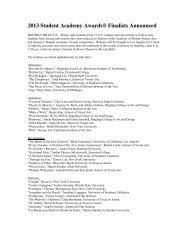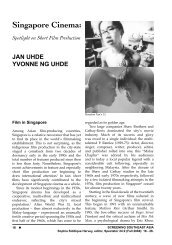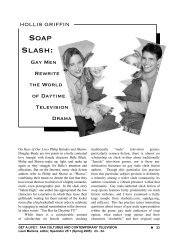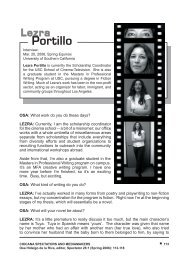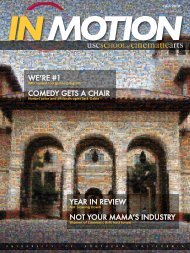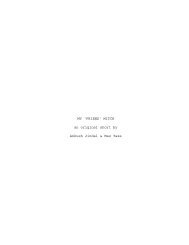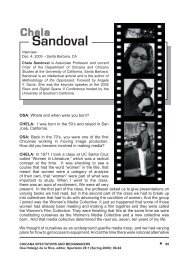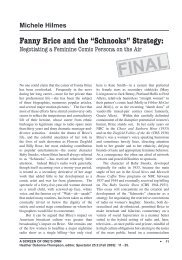The Instant Replay - USC School of Cinematic Arts - University of ...
The Instant Replay - USC School of Cinematic Arts - University of ...
The Instant Replay - USC School of Cinematic Arts - University of ...
Create successful ePaper yourself
Turn your PDF publications into a flip-book with our unique Google optimized e-Paper software.
in the etymological sense <strong>of</strong> the word,<br />
discernment. 33<br />
This process <strong>of</strong> discernment effects a “necessary<br />
poverty” <strong>of</strong> consciousness—we are only acutely<br />
aware <strong>of</strong> the most relevant pieces <strong>of</strong> sensory data.<br />
<strong>The</strong> same could be said <strong>of</strong> the replay—by necessity,<br />
the replay is confined to the medium in which it<br />
functions. <strong>The</strong> television replay does not replay<br />
anything external to the television broadcast, <strong>of</strong><br />
course. As such, the instigator <strong>of</strong> the replay—be<br />
it a television producer or a TiVo user—similarly<br />
exercises a degree <strong>of</strong> discernment through the<br />
processes <strong>of</strong> selection exercised to privilege<br />
certain moments and sequences over others. This<br />
privileging in turn may resonate culturally as<br />
well—consider the familiarity <strong>of</strong> sequences such<br />
as Lee Harvey Oswald’s assassination or the more<br />
recent “wardrobe malfunction” <strong>of</strong> Janet Jackson at<br />
the Super Bowl. 34 Furthermore, this demarcation<br />
and containment <strong>of</strong> a given time and space evokes<br />
something <strong>of</strong> a “necessary poverty.” In this sense,<br />
the replay’s discernment exposes the specificities<br />
<strong>of</strong> the medium—that is, the constitutive elements<br />
which define it and differentiate it from other<br />
forms but also its obsessions, preoccupations<br />
and traumas. 35 Through processes <strong>of</strong> selection,<br />
the television replay allows its viewers to fixate<br />
on specific moments and sequences as it replays<br />
them repeatedly, privileging these occurrences<br />
THE insTanT<br />
hAnSon<br />
over others in an unrelenting stream; similarly,<br />
Bergson defines our capacity to function in<br />
the present with an overwhelming amount <strong>of</strong><br />
external stimuli and past memories as a product<br />
<strong>of</strong> processes <strong>of</strong> discernment. Thus, much like<br />
specific elements <strong>of</strong> our conscious experience and<br />
memory are favored at particular moments (i.e.<br />
our focus upon the consecutive words on a page<br />
when reading and their relationship to both our<br />
memories <strong>of</strong> the text and personal experiences),<br />
the instant replay selectively concentrates the<br />
viewer’s focus upon certain limited portions<br />
<strong>of</strong> the televisual text’s past. In this sense, the<br />
replay functions in a fashion akin to Bergson’s<br />
discernment, as these moments and sequences<br />
are purposely differentiated from television’s<br />
continuous flow. <strong>The</strong> replay insists upon its<br />
own import amongst a stream <strong>of</strong> comparatively<br />
inconsequential information.<br />
<strong>The</strong> instant replay functions as a repetition<br />
within the program itself, and through its<br />
privileging <strong>of</strong> a specific section <strong>of</strong> a broadcast, it<br />
further enhances this portion <strong>of</strong> programming.<br />
That is to say, by replaying a particular sequence,<br />
the instant replay <strong>of</strong>ten divulges information<br />
which was previously hidden or unknown.<br />
New details are <strong>of</strong>ten revealed to the viewer—<br />
particularly when new camera angles or effects<br />
such as slow motion are employed—essentially<br />
broadening the experience and appreciation<br />
Fig. 4. February 1, 2004.<br />
Janet Jackson (left)<br />
and Justin Timberlake<br />
perform what would<br />
become “the most TiVoed<br />
moment” in history.<br />
57




